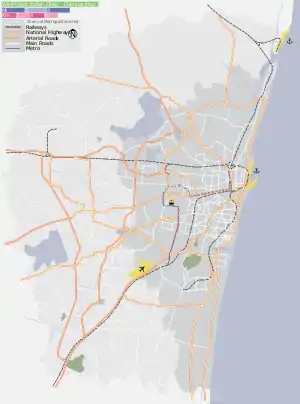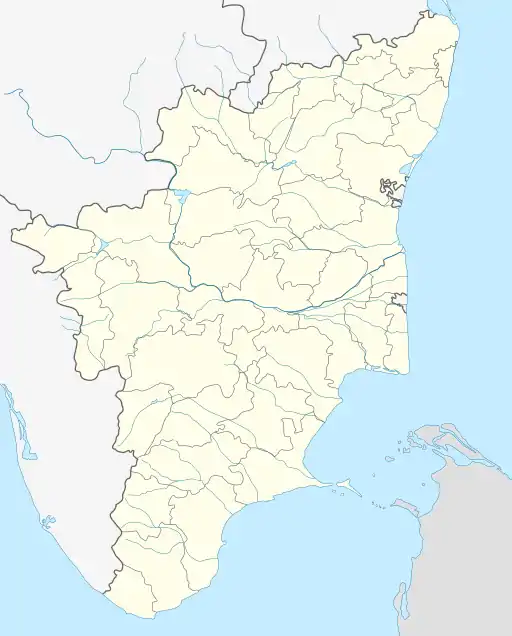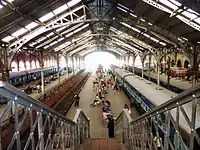Chennai Egmore railway station
Chennai Egmore (formerly known as Madras Egmore) (station code: MS) is a railway station in Chennai, Tamil Nadu, India. Situated in the neighborhood of Egmore, it is one of the four intercity railway terminals in the city and the other three railway stations are Chennai Central railway station, Tambaram railway station and Chennai Beach railway station. The station was built in 1906–1908 as the terminus of the South Indian Railway Company. The building built in Gothic style is one of the prominent landmarks of Chennai. The main entrance to the station is situated on Gandhi-Irwin Road and the rear entrance on Poonamallee High Road.
Chennai Egmore Madras Egmore | |
|---|---|
| Rapid transit, Light rail, Commuter rail, Regional rail and Terminal station | |
 Chennai Egmore | |
| Other names | Ezhumbur Station |
| Location | Gandhi-Irwin Road, Egmore, Chennai |
| Coordinates | 13.0780°N 80.2616°E |
| Owned by | Ministry of Railways, Indian Railways |
| Line(s) |
|
| Platforms | 11 |
| Tracks | 11 |
| Connections |
|
| Construction | |
| Structure type | Standard on-ground station |
| Parking | Available |
| Disabled access | |
| Other information | |
| Station code | MS |
| Zone(s) | Southern Railway zone |
| Division(s) | Chennai |
| History | |
| Opened | 1905 |
| Previous names | South Indian Railway |
| Passengers | |
| 3,00,000 per day | |
| Services | |
|
50 Express trains/day 400 suburban trains/day 50 DEMU services/day | |
| Location | |
 Chennai Egmore Madras Egmore Location in Chennai  Chennai Egmore Madras Egmore Location in Tamil Nadu  Chennai Egmore Madras Egmore Location in India | |
The station was apparently constructed from 8679 on land purchased from Pulney Andy.[1] The building is built in the Gothic style of architecture with imposing domes and corridors. It is one of the prominent landmarks of the city of Chennai. The recently opened northern entrance to this railway station is on the arterial Poonamallee High Road in Chennai city.
History


History says that the station was actually a fort, called the Egmore Redoubt, similar to Leith Castle, which is a part of Santhome. It is said that the station came up in a place that once used to store ammunition for the British.[2]
The station building was constructed on a 2.5 acres (1.0 ha) land, for which 1.8 acres (0.73 ha) was acquired from S. Pulney Andy, an English physician, who, in his letter to the 'Collector of Madras,' initially refused to sell his property owing to the difficulty with which he had purchased and developed the property. However, the South Indian Railway (SIR) Company, which was then operating train services to the south, persuaded him to sell the land, for which Andy claimed ₹1 lakh (US$1,400) as compensation. After acquiring the land, the SIR invited Henry Irwin, CIE (chief engineer), who did much of latter day Indo-Saracenic in Madras, and E. C. Bird, company architect, to design a building to suit the traffic need. After several alterations in the plan, the construction work began in September 1905 and was completed in 1908.[3] It was constructed by contractor T. Samynada Pillai of thirunageswaram near kumbakonnam at a cost of ₹17 lakh (US$24,000). The station was officially opened on 11 June 1908.[4][5]
There was initially a demand that the station be named after Robert Clive, which was, however, strongly opposed by the public as they wanted to name it Egmore. When the station was opened there was no electricity connection and a generator was used.[3] The station became the major metre-gauge terminal for Chennai after the formation of Southern Railway in 1951 and served as the gateway to the southern Tamil Nadu, chiefly due to its acting as a connecting point for passengers from the south to the Chennai Central for boarding north-, west- and east-bound trains. Irwin and Bird worked on the design of the building, which was sympathetically added to in the 1930s and 1980s.[4] In the 1990s it was converted into a major broad gauge terminal, a role in which it became operational in 1998.[6]
Earlier cars used to come inside the platform itself, which was found only in this station.[7] In its report, the SIR commented on the construction of a new building for Egmore:[3]
For some time it had been felt that the traffic to be handled in 'Madras' had outgrown the accommodation provided for it at the Egmore station and that something better was required. The old-fashioned, cramped station had done duty for many years as terminus for the South Indian Railway. Hence the move to construct a new station building for Madras.
SIR also claimed during the inauguration of the new building that it had given Madras a building to be proud of, "whose covered platform area is greater than that of Charing Cross Station in London."[3]
The signal cabin at the station was opened in 1935, when the suburban line between Madras Beach and Tambaram was electrified. The signalling of the station is controlled by a Siemens all-electric power frame of 1935.[8]
A new suburban station building was opened in November 2004 when the Tambaram–Beach broad-gauge section became fully operational. With increasing passenger traffic, the entrance on the Gandhi-Irwin Road eventually became insufficient.[3] In 2004, construction of a second entry to the station on the Poonamallee High Road side began at a cost of ₹11.53 crore (US$1.6 million).[9] In June 2006, the second entrance was opened.[3]
Layout
Chennai Egmore station lies between two flyovers separated by a distance of about 925 m (3,035 ft), measuring 300 ft × 70 ft (91 m × 21 m) on 2.5 acres (1.0 ha) of land[4] The station is about 750 m (2,460 ft) long and has 11 platforms. Platforms 1, 2 and 3 are on the eastern side. They are relatively short in length. They are used for short trains. Platform 4 is the main platform leading to the portico. Platforms 4, 5, 6 and 7 lie under the dome. These are used for long-distance trains. Platforms 10 and 11 are newly constructed ones that are handling broad-gauge electric multiple units (EMUs or suburban electric trains). Some platforms have escalators.
Chennai Egmore station is not a junction. This can be understood also from its name. It has one line towards Chennai Beach railway station (via Park Town and Fort), while the other is towards Tambaram railway station (via Mambalam).
Traffic
As of 2013, the station handles about 35 main line trains and 118 suburban trains, and about 150,000 people daily.[10] Its average daily earning is ₹17.06 lakh (US$24,000).[3]
The total revenue generated by the station during 2012–2013 was ₹287.3 crore (US$40 million), making it the second highest revenue-generating station of the Southern Railway, behind Puratchi Thalaivar Dr. M.G. Ramachandran Central railway station.
Maintenance

The station has been divided into two zones for mechanised cleaning contracts—platforms 1 to 6 fall under zone I and platforms 7 to 11 fall under zone II. In December 2012, Southern Railway awarded contract to a new agency with a 43-member team taking charge of upkeep of zone II.[11] Contracts for cleaning Chennai Egmore station has been awarded for a period of 3 years from 2010 for a value of ₹2.05 crore (US$290,000).[12]
Train care centre
The station has a train care centre named Egmore Railway Yard(GSN Yard – Gopal Samy Nagar), where the trains arriving at the station are prepared for departure. However, the centre is soiled and grimy due to lack of maintenance.[13]
Amenities
There are 14-bedded air-conditioned dormitories and 16 retiring rooms on the first floor of the station. Three new waiting halls were added to the prepaid AC hall and second call hall.[14] In 2019–2020, platforms 5, 7, 8, and 9 were extended to accommodate locomotives.[14]
Connectivity
The station has two entrance, viz. the main southern entrance on the Gandhi–Irwin Road and the secondary northern entrance on the Poonamallee High Road. Both the entrances has MTC bus routes passing through them and have pre-paid taxi and autorickshaw counters.[15] While the southern entrance has a bus shelter, the northern entrance has a two-storey parking lot and a bus terminus.[16][14]
Security

In April 2012, the Government Railway Police (GRP) and the Railway Protection Force (RPF) together launched a helpline known as Kaakum karangal (literally meaning 'Protecting hands') in the terminus. This involved dividing the terminus into three sectors and deploying 18 police personnel for security.[17]
The main station has CCTV cameras installed. The suburban platforms are covered by the ₹40 crore (US$5.6 million) Integrated Security Surveillance System (ISSS) project implemented in 2012. The project, implemented jointly by the Southern Railways and HCL Infosystems, includes installation of CCTV cameras that would record visuals around the clock and store the data for 30 days, with the footage transmitted and stored using an Internet Protocol system.[18]
Future

The station serves not only to the south but also to the north (Hyderabad) and east (Howrah). Additionally, the Chennai–Mumbai Dadar Central Express (west) originates from the Egmore station.[3][19]
As the growth potential at Chennai Egmore station is limited due to space constraint, the railway is planning to originate or terminate some of the additional trains to be introduced in future at Tambaram railway station. However, the station will remain a hub of train services and there is no proposal to shift all the services to Tambaram.[20][21]
In February 2013, as part of a national initiative to eliminate ballast tracks at major stations, washable aprons—ballastless tracks or tracks on a concrete bed—were laid along the entire length of track of platform 2 at the terminus.[22]
The station will also be connected to the Chennai Metro Rail Line 2, serving as an underground station.[23]
Legacy
Though several changes were made to the station, the letters "SIR" emblazoned on its bas relief crest still remains, though the middle letter 'I' was painted out a few years ago to read "SR" (meaning Southern Railway).[4]
See also
References
- Muthiah, S. (27 October 2012) [19 September 2010]. "Whither this National Library?". Madras Miscellany (column). The Hindu. Retrieved 21 June 2019.
- Pain, Paromita (27 June 2008). "Heritage tracks". Business Line. Chennai. Retrieved 8 November 2012.
- "Red-letter day for Southern Railway". The Hindu. Chennai. 11 June 2008. Retrieved 17 June 2012.
- Muthiah, S. (16 June 2008). "Egmore and the South". The Hindu. Chennai. Retrieved 29 December 2011.
- Muthiah, S. (9 May 2010). "The railway of the Deep South". The Hindu. Chennai. Archived from the original on 17 November 2010. Retrieved 28 December 2011.
- "One hundred years of tireless travel ... still chugging with charm". The Hindu. 7 June 2008. Retrieved 24 May 2011.
- Krishnaswamy, Murali N. (17 June 2008). "Chugging on . . . a hundred years hence". The Hindu. Chennai: Kasturi & Sons. Retrieved 28 September 2019.
- Hinson, John. "Madras Egmore: South Indian Railway". The Signal Box. Archived from the original on 18 April 2002. Retrieved 9 September 2013.
- Vydhianathan, S. (26 October 2004). "Second terminal at Puratchi Thalaivar Dr. M. G. Ramachandran Central Railway Station proposed". The Hindu. Chennai. Retrieved 9 November 2012.
- Venugopal, Vasudha (5 February 2013). "Display boards at station fail to show the way". The Hindu. Chennai. Retrieved 11 February 2013.
- Varma, M. Dinesh (7 December 2012). "New agency undertakes cleaning of Egmore station". The Hindu. Chennai. Retrieved 13 December 2012.
- "Cleanliness drive in railway stations". The Hindu. Chennai. 8 July 2010. Retrieved 7 November 2012.
- Ayyappan, V. (29 October 2012). "Passengers panic as pests overrun dirty train bogies". The Times of India. Chennai. Retrieved 10 November 2012.
- Express News Services (26 November 2019). "Egmore railway station to have better services for commuters". The New Indian Express. Chennai: Express Publications. Retrieved 24 October 2020.
- Ayyappan, V. (1 August 2014). "One more prepaid autorickshaw counter opened at Egmore Railway Station". The Times of India. Chennai. Retrieved 24 October 2020.
- Madhavan, D. (5 October 2019). "Whenners Road hit by 'pothole plague'". The Hindu. Chennai: Kasturi & Sons. Retrieved 24 October 2020.
- "Railway police launches two helplines". The Hindu. Chennai. 1 May 2012. Retrieved 25 November 2012.
- "Chennai: Suburban railway stations to come under CCTV surveillance". IBN Live. Chennai. 18 July 2012. Retrieved 14 January 2014.
- "Train Timings (from 1.7.12) at Chennai Central, Chennai Egmore, Perambur, Tambaram" (PDF). Southern Railway Website PDF Upload. Southern Railway. Retrieved 20 August 2012.
- "Egmore to remain railway hub". The Hindu. Chennai. 22 December 2011. Retrieved 31 December 2011.
- Malavan, K. (20 January 2012). "Tambaram 3rd Rail Terminus update". The Hindu. Chennai. Retrieved 20 January 2012.
- Ayyappan, V. (14 February 2013). "Puratchi Thalaivar Dr. M. G. Ramachandran Central Railway Station, Chennai Egmore Railway Station to get washable tracks". The Times of India. Chennai. Retrieved 17 February 2013.
- "Chennai Metro Rail Line Map". Archived from the original on 13 July 2014.
.jpeg.webp)
